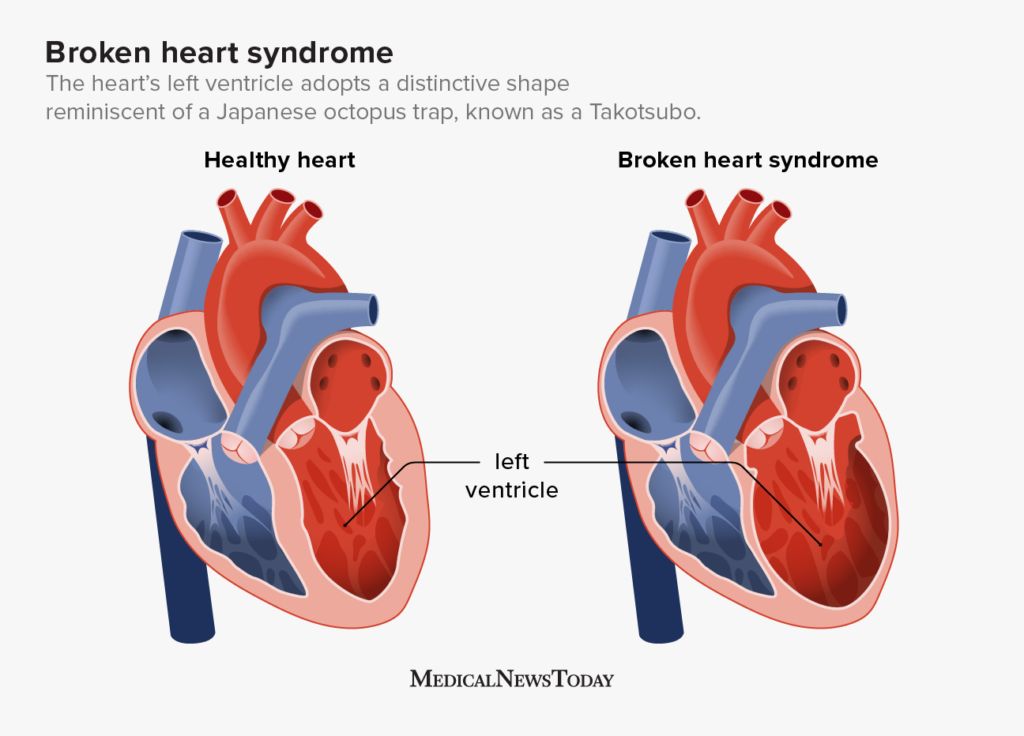Broken heart syndrome is also known as stress cardiomyopathy or takotsubo syndrome. Symptoms are similar to a heart attack and occur when a person experiences severe emotional or physical stress.
When an individual has a stressful life event, they may experience something known as broken heart syndrome, a temporary heart condition that extreme emotional or physical stress can trigger.
While it mimics the symptoms of a heart attack, broken heart syndrome differs significantly in its cause, mechanism, and recovery.
Understanding this condition is crucial for effective management and recovery. In this article, we examine broken heart syndrome, its symptoms, causes, diagnosis, treatment, tips for prevention, and when to seek medical attention.
When discussing
Medical imaging, such as echocardiograms and angiograms, reveals that the heart’s left ventricle
These images can show the ballooning of the left ventricle and provide crucial insight into the diagnosis and progression of the syndrome.
Learn more about takotsubo cardiomyopathy.
Broken heart syndrome is a
Unlike a typical heart attack that usually occurs due to a blockage of the arteries, broken heart syndrome results from a sudden surge in stress hormones, such as adrenaline. These hormones temporarily stun the heart and impair its ability to pump blood effectively, causing symptoms
Females over the age of 65 make up
Broken heart syndrome has various names, including:
- stress cardiomyopathy
- takotsubo cardiomyopathy
- Gebrochenes-Herz syndrome
- transient apical ballooning syndrome
- apical ballooning cardiomyopathy
The symptoms of broken heart syndrome usually begin suddenly after an extreme stressor. They closely mimic those of a heart attack and may include:
- chest pain
- shortness of breath
- irregular heartbeat (arrhythmia)
- fainting
- low blood pressure
- fatigue
- palpitations
Approximately
If individuals experience symptoms similar to those of a heart attack, they should seek immediate medical attention. It is essential to differentiate between heart attack and broken heart syndrome and initiate appropriate treatment.
Although broken heart syndrome is temporary and reversible, the symptoms can be severe. Individuals should seek emergency medical care immediately if they experience symptoms similar to those of a heart attack, including:
- unexplained chest pain
- shortness of breath
- rapid or irregular heartbeat
Delaying evaluation or treatment can increase the risk of complications and impact recovery.
Doctors do not yet fully understand the exact cause of broken heart syndrome, but they believe it involves a combination of factors, such as a surge of stress hormones and a coronary artery spasm. Genetics may also play a role.
Emotional stressors
For some people, emotional distress can trigger broken heart syndrome. Common emotional triggers include:
- fear
- bereavement and grief
- severe and sudden illness
- domestic or emotional abuse
- physical assault
- recent surgery
- financial worries
- being involved in a disaster
Physical stressors
Physical stressors may also cause broken heart syndrome. Triggers include:
- surgery
- severe illness
- significant exertion
If a doctor suspects an individual has broken heart syndrome, they may carry out different tests to confirm a diagnosis and rule out a heart attack. Tests may include:
- Medical history and physical exam: Understanding the patient’s recent stressors and symptoms is crucial. A doctor may ask if an individual has been under any extreme stress recently, such as the death of a loved one.
- Electrocardiogram (ECG): This is a test that checks the electrical activity of the heart and can help differentiate between a heart attack and broken heart syndrome.
- Blood tests: A blood test can detect high levels of certain enzymes and proteins that may indicate heart damage.
- Echocardiogram: This technique uses ultrasound technology to examine the heart and can reveal the characteristic shape of the left ventricle.
- Cardiac MRI scan: A cardiac MRI is a scan of the heart and blood vessels that shows detailed pictures of the inside of the heart.
- Coronary angiogram: This imaging test uses dye and X-rays to check for blockages in the coronary arteries, which are typically absent in broken heart syndrome.
Depending on the diagnosis, a doctor will recommend an appropriate treatment strategy.
Treatment for broken heart syndrome focuses on relieving symptoms and supporting heart function while the heart recovers. Common treatments include:
Medication
To reduce the heart’s workload and manage symptoms, a doctor may prescribe medications, such as:
Lifestyle modifications
Stress management techniques can help prevent the condition from recurring. These include:
- counseling
- relaxation techniques
- physical activity
With appropriate medical care and lifestyle adjustments, the outlook for broken heart syndrome is generally favorable, with most individuals experiencing a complete recovery within a few weeks to months.
About
- blockage in the heart’s left ventricle
- irregular heartbeat, or arrhythmia
- reduced blood flow from the heart
- heart failure
- blood clots
Following treatment plans is crucial for preventing complications and ensuring optimal heart health. A doctor may also recommend regular follow-up appointments to monitor heart function and help ensure a full recovery.
Preventing broken heart syndrome may involve strategies such as:
- Stress management: Techniques such as mindfulness, meditation, yoga, and deep breathing exercises can reduce stress levels.
- Healthy lifestyle: Regular physical activity, a balanced diet, and sufficient sleep contribute to overall heart health.
- Emotional support: Building a strong support network of friends, family, and professionals can help manage emotional stressors.
- Medical management: For individuals with a history of broken heart syndrome, a doctor may prescribe medications to prevent recurrence.
Broken heart syndrome, a temporary heart condition that often occurs due to intense stress, can mimic the symptoms of a heart attack but differs in its underlying causes and treatment. Recognizing the symptoms and seeking prompt medical attention are crucial for effective management.
With appropriate care, most individuals recover fully, but ongoing stress management and lifestyle adjustments are essential for preventing recurrence. Understanding and visualizing the condition through medical imaging can enhance awareness and guide effective treatment strategies.

